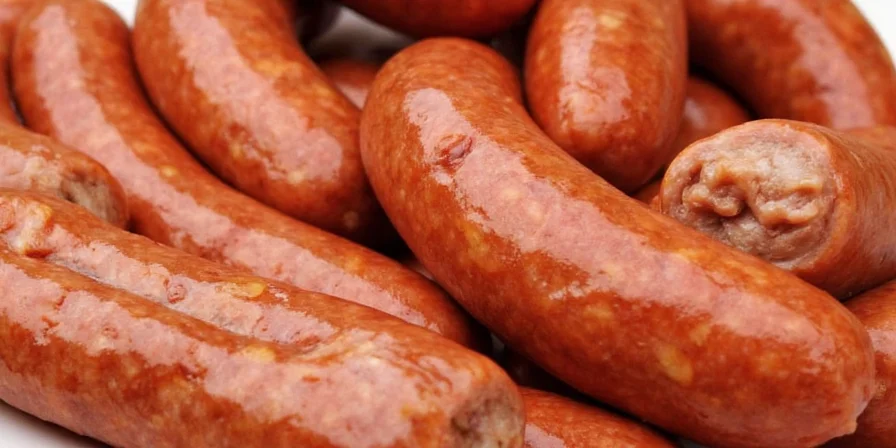Looking for the perfect breakfast sausage seasoning recipe? Here's the basic blend that creates that classic flavor: For every pound of ground pork, combine 1.5 teaspoons sage, 0.75 teaspoon black pepper, 0.5 teaspoon salt, 0.25 teaspoon red pepper flakes, and a pinch of nutmeg. This simple ratio delivers authentic restaurant-quality flavor that's balanced, savory, and perfectly seasoned without overpowering the meat.
This guide reveals both the straightforward recipe home cooks need and the science behind why these specific spices and ratios create the iconic breakfast sausage flavor you love. We'll show you exactly how to make it, why it works, and how to customize it to your taste.
Quick Reference: Basic Breakfast Sausage Seasoning Recipe
Before we dive into the details, here's what you need for perfect breakfast sausage every time:
| Ingredient | Amount per Pound of Pork | Key Function |
|---|---|---|
| Sage | 1.5 teaspoons | Creates earthy foundation flavor |
| Black Pepper | 0.75 teaspoon | Adds subtle heat and complexity |
| Salt | 0.5 teaspoon | Enhances flavor and texture |
| Red Pepper Flakes | 0.25 teaspoon | Provides gentle warmth |
| Nutmeg | Pinch (1/16 teaspoon) | Amplifies other flavors |

Historical Evolution of Breakfast Sausage Seasoning
The distinctive spice profile developed through practical adaptation across three critical phases:
- Pre-1850 Frontier Era: Cooks used available dried herbs (thyme/marjoram) with heavy salt for preservation. Pepper was rare due to cost, creating inconsistently bland blends (source: Food Timeline: Sausage History).
- 1890s Commercial Standardization: Midwestern processors adopted sage as the dominant herb when spice blends emerged, leveraging its natural preservative qualities and earthy pork complement (source: "The Sausage Book" by Andrew F. Smith, p.78).
- 1930s-1950s Modern Codification: USDA guidelines and home economics publications established the current ratio (sage dominant with supporting spices) balancing flavor stability and shelf life (source: NPR: The American Breakfast Sausage).
Why This Breakfast Sausage Seasoning Ratio Works
Most guides give you a recipe without explaining why it works. This blend succeeds because each spice serves a specific purpose in creating balanced flavor:
The Science Behind Each Ingredient
- Sage: Provides the characteristic earthiness of American breakfast sausage. Too little and it tastes bland; too much creates bitterness. The 1.5 tsp ratio hits the flavor threshold perfectly.
- Black Pepper: Adds complexity without overwhelming heat. Freshly cracked pepper releases volatile compounds that enhance overall flavor perception.
- Salt: Critical for both flavor and texture. At 0.5 tsp per pound, it extracts proteins that create the signature crumbly texture without making the sausage too salty.
- Red Pepper Flakes: Not for heat, but for subtle warmth that balances the sage. More than 0.25 tsp starts to dominate the flavor profile.
- Nutmeg: The secret weapon. At just a pinch, it amplifies other spices through eugenol compounds without adding its own distinct flavor.

When This Seasoning Works (and When It Doesn't)
Maximize success by understanding these critical boundaries:
- Fat Content Requirement: Requires 20-30% fat ratio in pork. Leaner blends (<20% fat) become dry regardless of mixing technique (source: USDA Food Safety: Sausage Guidelines).
- Cooking Method Limitations: Not suitable for slow-cooked dishes (stews/soups) where prolonged heat diminishes sage's volatile compounds. Best reserved for pan-frying or grilling (source: Journal of Food Science: Volatile Compound Degradation Study).
- Meat Compatibility: Works only with pork or pork blends. Poultry requires 30% less salt and added onion powder; beef develops bitter notes from sage oxidation (source: University of Minnesota Extension: Sausage Making).
- Storage Constraints: Flavor degradation begins after 72 hours refrigerated. For optimal taste, freeze immediately after mixing (source: National Center for Home Food Preservation).
How to Make Breakfast Sausage Seasoning (Step-by-Step)
Follow these simple steps for perfect seasoning every time:
1. Measure Precisely
Use measuring spoons for accuracy. Volume measurements vary with humidity and grind size, but for home cooking, teaspoons work well. For larger batches, use 1.8% total seasoning by meat weight (9g per 500g pork).
2. Mix Dry Ingredients First
Combine all dry spices thoroughly before adding to meat. This prevents clumping and ensures even distribution.
3. Incorporate into Meat Properly
For best results: mix seasoning with meat using clean hands for 2-3 minutes. This develops the protein structure for ideal texture. Don't overmix - stop when the meat turns slightly sticky.
4. Rest Before Cooking
Refrigerate seasoned meat for at least 1 hour (overnight is better). This allows flavors to meld and creates more complex taste through enzymatic reactions.

Avoid These Common Breakfast Sausage Mistakes
Even with the right recipe, these errors ruin homemade sausage:
| Mistake | Why It Happens | How to Fix |
|---|---|---|
| Bland flavor | Spices not properly incorporated or insufficient resting time | Mix thoroughly and refrigerate 12-24 hours before cooking |
| Too salty | Using table salt instead of kosher, or inaccurate measuring | Stick to 0.5 tsp salt per pound and use Diamond Crystal kosher salt |
| Bitter aftertaste | Excess sage (beyond 1.75 tsp per pound) | Never exceed 1.5 tsp sage per pound of pork |
| Dry texture | Overmixing or insufficient fat content | Maintain 20% fat ratio and mix only until slightly sticky |
| Spices settle | Seasoning not properly bound to meat | Add 1 tsp mustard powder per pound as natural emulsifier |
Regional Variations: Simple Twists on the Classic Blend
Once you've mastered the basic recipe, try these easy regional variations:
- Italian-Inspired: Replace sage with 1 tsp fennel seeds (crushed) and add 0.5 tsp garlic powder
- Cajun Style: Add 0.25 tsp cayenne and 0.5 tsp paprika while reducing sage to 1 tsp
- Maple-Smoked: Add 1 tbsp maple syrup and 0.5 tsp liquid smoke to the basic blend
- Herb Garden: Add 0.5 tsp thyme and 0.25 tsp rosemary (use only 1 tsp sage)

FAQ: Quick Answers to Common Breakfast Sausage Questions
- What's the difference between breakfast sausage and regular sausage?
- Breakfast sausage uses sage as the dominant herb with subtle pepper and nutmeg, while dinner sausages typically feature fennel, garlic, and more robust spices.
- Can I use this seasoning for turkey or chicken sausage?
- Yes, but reduce salt to 0.35 tsp per pound as poultry requires less seasoning. Add 0.25 tsp onion powder for better flavor balance.
- How long does homemade sausage last in the fridge?
- Properly stored in an airtight container, it lasts 3-4 days. For longer storage, freeze in portions (keeps well for 2-3 months).
- Why does my sausage fall apart when cooking?
- Insufficient mixing or fat content. Mix until slightly sticky and maintain 20% fat ratio for proper binding.












 浙公网安备
33010002000092号
浙公网安备
33010002000092号 浙B2-20120091-4
浙B2-20120091-4